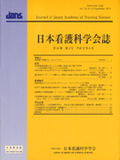Japanese
English
- 販売していません
- Abstract 文献概要
- 参考文献 Reference
- サイト内被引用 Cited by
要旨
目的:新人,中堅,ベテラン看護師の留置針による血管確保技術の特徴を明らかにする.
方法:新人20名,中堅25名,ベテラン45名を対象とし,血管確保技術をビデオ録画を用いて観察した.手技時間,血管確保成功率,失敗要因などを3群により比較した.
結果:留置針刺入部位の選定時間は新人59.4秒,ベテラン44.1秒,留置針刺入時間は新人109.4秒,ベテラン66.6秒であり新人が有意に長かった.1回の穿刺による成功率は新人35.0%,中堅44.0%,ベテラン75.6%,2回以内の成功率は新人65.0%,中堅68.0%,ベテラン93.4%であった.失敗要因は,新人は「刺入時に血液の逆流なし」,中堅は「内針抜去時に血液の逆流なし」が最多であった.
結論:新人はベテランより「留置針刺入部位の選定」および「留置針刺入」の手技時間が長い.1回の穿刺による成功率は新人35.0%,中堅44.0%,ベテラン75.6%であった.新人は正しく留置針を血管内に刺入することが困難であり,中堅は外針を留置する巧緻性に習熟していない.
Abstract
Objectives: To elucidate the characteristics of skill in placing with a peripheral-short catheter by new, mid-career, and experienced nurses.
Method: This study targeted 20 new nurses, 25 mid-career nurses, and 45 experienced nurses, wherein their skill in placing a catheter was observed by video recording. The time required to perform the procedure, the success rate of the catheter placement, and the failure factors were compared among these 3 groups.
Results: Significant differences were observed in the procedure time for the following instances: the time required to select an insertion site, wherein new nurses took 59.4 seconds and experienced nurses took 44.1 seconds; and the time required to insert a catheter, wherein new nurses took 109.4 seconds and experienced nurses took 66.6 seconds. The success rate for a single insertion was 35.0% for new nurses, 44.0% for mid-career nurses, and 75.6% for experienced nurses, and the success rate for twice insertion was 65.0% for new nurses, 68.0% for mid-career nurses, and 93.4% for experienced nurses. The failure factors were mostly as follows: for new nurses, “no reflow of blood after insertion”; and for mid-career nurses, “no reflow of blood after removal of the stylet.”
Copyright © 2010, Japan Academy of Nursing Science. All rights reserved.


